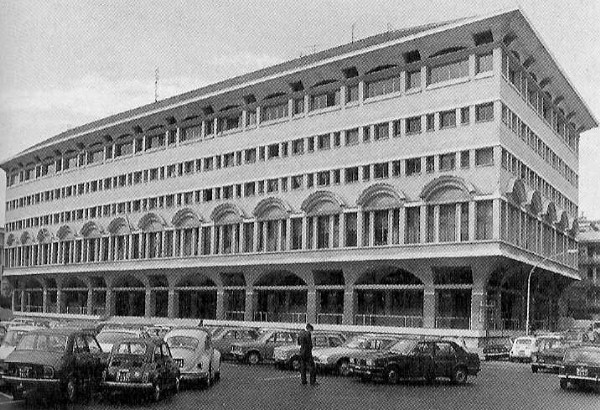| |

Saverio Muratori Palazzo of the Christian Democratic Party EUR Rome 1955-58
| |
"By that time I had begun to understand architecture, and we were ready to stage the first faculty occupation of the department. There had been earlier demonstrations all over Italy. In any case, the first was in 1958. It was deeply flawed, because our pretext for demonstrating was the introduction of the state exam for architects. We were a bit cynical, and we thought we needed to come up with arguments that would stir our ignorant colleagues to action, to stage something that would violently shake up the entire department.
The most important thing is that we were looking for pretexts, weak links in a chain, in order to effect disruption. We used to say that we had a little bit of the whole world concentrated within the department. But that whole world was conceived, as Antonio Cederna taught, as a protest against corrupt building practices from which emerged a political comprehension of the situation. All of us followed the trial of Salvatore Rebecchini/L'Espresso with tremendous anxiety, not least because it was our bible. And we found that we had in front of us at a certain point Saverio Muratori, a figure who taught fourth- and fifth-year design studios. He had just arrrived in Rome from Venice, and was a well known personality. Muratori was the architect of the Christian Democrat office at the EUR. He was someone unique, someone who had strong intellectual resonance, someone who could really think. He proposed a rather tragic vision of history, because for him the crisis began at least inthe 18th century. It seemed like one didn't need to think so much about [Hans] Sedlmayer, but rather about someone who had contemplated the crises in isolation and suffered considerably; suffered for the world. These crises seemed to be the crises of European science, of Husserl. Muratori, advocating an extreme reductive culture, was against everything that was modern. This is the point. He thought that true modernity meant that everything should start all over again. This was a facinating point of view.
We could not allow ourselves to think about these things because they were minor in relation to certain much larger problems. But Muratori was the person we wanted to confront because he was invulnerable. He refused to talk with us because his way of thinking only functioned if it remained closed to dialogue. At this point he realized that he was just another weak link, so we organized the operative concept of "libera d'insegnamento" [freedom of teaching]. And then there also had to be "freedom of learning.""
Manfredo Tafuri, "History as Project: An Interview with Manfredo Tafuri" (1992).
|
